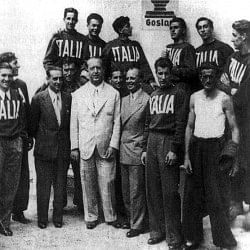
The fall and rise of the Gigliati
‘Nothing lasts forever; All good things have to come to an end’
This old adage has proven to be the undoing of many an institution, many an era. Be it in the political sphere, the social sphere or the sporting sphere. Flipping through the pages of history, one will come across many such incidents where ‘such and such’ a thing enjoyed prominence but one strong gust of wind reduced it to ashes, and it was nowhere to be seen henceforth.
Such has been the case of a football club, based in Florence – the city situated in the Tuscany region of Italy. ACF Fiorentina is the club that I am talking about – a club built upon the pillars of unity, to give competition to the elite of ‘Il Calcio.’
How was it brought into existence?
Calcio, in the 1920′s , was dominated by the two big giants – Milan and Juventus (a pattern much similar to the present day Liga BBVA.) Florence, at that time, was represented by two clubs – CS Firenze and PG Libertas. In an audacious attempt to change the power center in Italy, Luigi Ridolfi merged the two bodies into one – thereby giving birth to ACF Fiorentina, in the autumn of 1926.
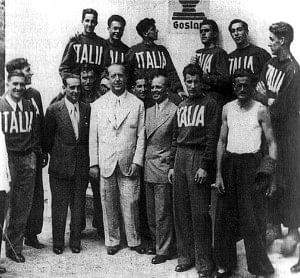
Luigi Ridolfi – The man in the center
Era of Uncertainty
After enjoying a pretty topsy turvy start of what was to be a Roller Coaster (better than any in the modern day’s amusement parks), the Viola were about to witness a revolution of sorts. Flavio Pontello, who hailed from a rich house building family, brought the club and marked the beginning of what was to be an upward spiral for the Tuscany based club. The new owner made an immediate impression by changing the club’s logo and the anthem – a move which drew a multitude of flak from many sections of the fanbase. Realizing that the fanbase was the very lifeblood of a club, the new owners reacted quickly and brought in quality players to the Artemo Franchi, the most notable among them being Daniel Mazzaro and Pietro Vierchowod.
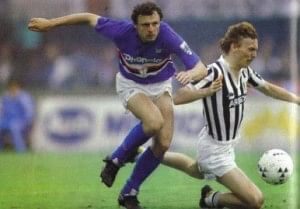
- Pietro Vierchowod – Big money, small return
But as we all know – Football is a funny game. Sometimes, even the best find the going tough, whereas the mediocre thrive under the roughness and toughness of time. It was a strange time for the Viola. The club’s stature fluctuated every season – from the top of the ladder to it’s basement. It was all helter and skelter. The big names weren’t consistent enough – which led to a change in policy.
Instead of splashing the cash on established household names, the hierarchy decided to direct their funds towards the development of youth – to provide a platform for the deserving to showcase their talent to the world, which ultimately led to the transfer of the finest player Il Calcio was going to see – Roberto Baggio – from Vincenza.
But, nothing seemed to work out, as the Gigliati fought for survival until the last day of the 1989-90 season, a season which witnessed the departure of Baggio to bitter rivals Juventus.
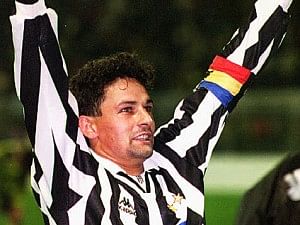
Baggio turned his back on Fiorentina for a bigger stage
Batigol’s Fiorentina – A Delight to the eyes of the beholder.
Following mass protests by the ‘Tifosi’ (group of supporters) because of the sale of Baggio, Fiorentina’s ownership changed hands yet again. Cecchi Gori acquired the club – amid huge expectations of the revival of a falling institution, and he did not fail to deliver either. The first season under Gori was a period of stabilization – where he oversaw the transfers of Stefan Effenberg, Rui Costa and most importantly – Gabriel Batistuta, who would set Florence alight pretty soon.

Batistuta : Florence's heart-throbber
A constant shuffle of managers saw Fiorentina being relegated to Serie B. The Tinkerman, Claudio Ranieri was appointed coach and subsequently, Fiorentina dominated the second division. Upon its return to the First division, the club’s managerial structure was always in the doldrums – with coaches being changed like players exchanging jerseys. But, what remained constant was the phenomena called Batistuta. He won over the support of the fans by scoring goals for fun. With Effenberg holding the midfield alongside Costa – who run the show for Fiorentina, feeding Batigol everytime a chance came across.
In 1999, under Trapattoni, the dynamic duo of Rui Costa and ‘Batigol’ set Florence into a Frenzy, as the Viola managed to upset the likes of Arsenal and Manchester United, with the duo putting in performances to savour for a lifetime.
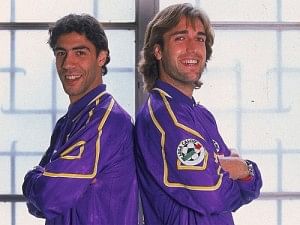
Dynamism : The duo gave a whole new meaning to the term.
Bankruptcy and time in the dark
The dawn of the 21st century brought along with it, the dawn of an era which would oversee the club’s fortunes reaching the nadir of fate. Batistuta was sold to AS Roma, as he had grown unhappy with the lack of return for his efforts – he had not collected a winner’s medal for 3 seasons now. Having the ‘Scudetto’ inscribed on his jersey is a dream for every player who is a part of Calcio, and with Fiorentina unable to challenge for the top, Batistuta felt that a move to Roma would prove to be the perfect opportunity to him. The chance of sharing the dressing room with the ‘Prince of Rome‘ was an offer which was to lucrative to turn down.

Batistuta – From Hero to Nemesis
The mismanaged finances of the club finally came to the fore in the 2000-01 season. Fiorentina were in the red by USD 50 Million( yes, a pretty small amount today, but a monumental figure in the good old days) The overflowing wage bill along with the club being saddled by debts proved to be the ultimate downfall. The owner raised funds privately, and the players were asked to take pay cuts so that the club would not stop ‘breathing.’ And to add the icing on the cake of the rivals – Fiorentina were relegated that season. The precarious state of finances meant that the club went into administration, and were even barred from competing in Serie B. Effectively, the club ceased to exist – its operations came to an undeserving and tragic halt. In fact, the tattered finances had already gone down so badly, that even the £40 Million sale of star playmaker Rui Costa could not rescue the amalgamated finances of the club.
Fiorentina filed for Bankrupcy – it’s life came to a tragic end. When everything seemed alright, fortune decided to part ways, leaving the club in a conglomeration of dark clouds, which poured heavily – probably symbolic of the tears of the Viola faithful.
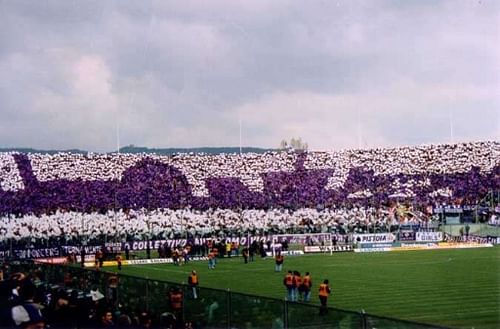
Fans react to the Viola's end
Re-birth and the climb back
Diego Della Valle – the shoe and leather entrepreneur, bought the club in the summer of 2002, and promptly moved to re-establish the club on newly constructed foundations. The Viola came back to life in August 2002 as Associazione Calcio Fiorentina e Florentia Viola. Pre its dissolution, the big names left the Artemo Franchi for greener pastures. But there was one, which stood firm, much like the North star. Angelo Di Livio, the man who came from Turin, was somewhat of a fans’ target in his early days in Florence. But his firmness and unsurpassed loyalty to the club during thick and a prolonged thin time, endeared him to the Viola faithful.
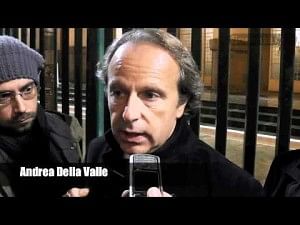
Dalle Valle on gaining control.
After spending the gloom of the night within the four walls of courts, fighting for the very essence of it’s valued existence, Fiorentina were finally back to where they belonged – the Football ground. They were admitted into Serie C2, the basement of the ladder which was to be climbed. Led by Di Livio, a re-incarnated Viola gained promotion as champions of C2. According to the domestic structure, the club was to compete for the Serie C1 the following season, but fortune decided to intervene. The bizzare case of ‘Caso Catania‘ prompted the FIGC to expand the base of Serie B from 20 to 24 teams. Consequently, Fiorentina were promoted to Serie B on grounds of ‘”sports merits.” However, one cannot appease all by his/her decisions, and it proved to be the same in this case as many quarters of the Italian media lambasted the FIGC for it’s ‘apparent’ prejudice for the Viola. A Tabloid read :
” Fiorentina was suppose to go down to Serie D last year. When a team goes bankrupt (or can’t pay the league entrance fees), the rule states that they end up in Serie D. So, 2 years in a row now, the FIGC has helped Fiorentina out. As for Catania, there is a rule stating that playing an ineligible player results in a loss, but the league decided not to accept Catania’s protest, that is why Catania went to the courts. “
There was to be further joy and delight for the club as it gained promotion to return to the Serie A the following season. Dalle Valle, had surely, managed to ‘mend’ the torn fortunes of Fiorentina. They were back. Back with a hope, a belief and a big pot of expectation to reach the former stature, achieved by Batigol’s team.
There was an alarming similarity of the Viola under Prandelli, and the Viola under Ranieri. One would obviously not make the grave mistake of comparing Luca Toni to Batistuta, or Stefano Fiore to Rui Costa. But Prandelli’s Viola were endeared by the fans in their own special way – not because of the memories that Fiore-Toni gave, but because this bunch had lifted the Viola from darkness to sunshine, from gloom to smiles.
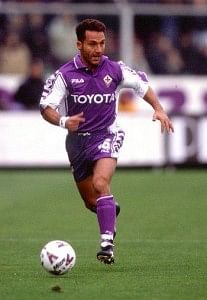
Di Livio – Loyalty unmatched.
Calciopolli and the time after.
The incident that put Italian football to shame and shook it’s very pillars also had it’s effect on Florence. The Viola were proven to have played a part, and were hence relegated to Serie B, but a subsequent case re-instated them back to Serie A, but they were docked 19 points, which was later reduced to 15. But this did not deter the Viola spirit even a bit. Adrian Mutu and Luca Toni breezed their way past defenders, as the train whiskers pass fields. Defenders did not have a clue about the duo’s lethal movement, as they wreaked havoc. Fiorentina managed to book a UEFA Cup berth despite their points deduction at the start of the season.
As time moved, the star quotient of Florence moved elsewhere. Luca Toni left for Germany, as Bayern Munchen came calling. But this did not deter the Viola spirit as they were tipped by the then Italy boss Marcelo Lippi to be the darkhorses in the Scudetto race. Fiorentina reached the semi-finals of the UEFA Cup where they were knocked out by Rangers on penalties.
The 2009-10 season was a historic one on the European front. Fiorentina were placed alongside Liverpool, Lyon and Debrecen in the UEFA Champions League group stage. The new power bloc on the map of ‘Il Calcio’ had it’s date with history, as it emerged as group winners, humbling Liverpool at home and on the famous road that led to the Cauldron named Anfield.
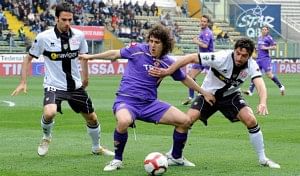
Jovetic – the new star of the Viola.
Post Prandelli’s appointment as coach of La Nazionale, Fiorentina have taken a bit of dip, meandering about the din of mid table clubs. The boardroom and the managerial setup has been in the doldrums, with the Viola chopping and changing on a regular basis., the major of them being the stepping down of Dalla Valle as president, because of the flak drawn for not investing the money earned via the sale of Felipe Melo to rivals Juventus, and Giampaolo Pazzini to Sampdoria.
At the minute, Fiorentina are indubitably the most profitable club in Serie A,but maintaining the tag without the glamour of European football and/or a major influx of cash through the sale of a star seems difficult. It might directly imply the sale of either Vargas or Jovetic – one of the many wunderkids. Of course, that would almost certainly damage the club’s prospects of getting back into the Champions League, so it’s the usual dilemma: profits or performance?
That’s a difficult question to answer, as it’s almost impossible to have both. Instead, one could marvel at the spectacular yet turbulent history of this club, and it is indeed fitting that such a club hails from a city famed for it’s period under the Italian Renaissance.